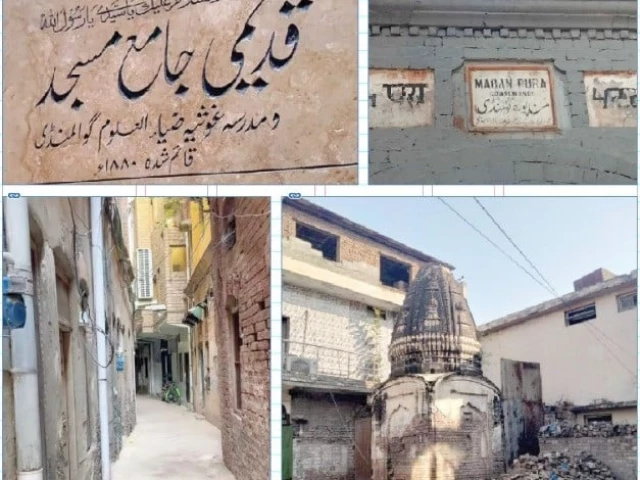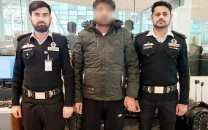Historic Gawalmandi crumbles amid neglect
Ancient locality stands as fading relic of Rawalpindi's diverse past

Gawalmandi, located in the heart of Rawalpindi city and cantonment, carries the mark of 200 years of history.
It is the only residential and commercial locality where Hindus, Sikhs, Muslims, and Christians have lived together since its inception.
The area still houses century-old temples, churches, gurdwaras, and the historic Jamia Mosque built in 1880.
In the past, wealthy families and traders preferred to live in Gawalmandi due to its proximity to wholesale markets, Raja Bazaar, Liaquat Bagh, the railway station, and major business centres.
The old neighbourhood still retains its narrow three-foot-wide streets lined with two- and three-story houses made of wood, clay, and brick — exquisite examples of 150- to 200-year-old architecture.
The old windows and doors of these crumbling structures still reflect a blend of European and Mughal design. Historic neighbourhoods such as Anandpura, Madanpura, and Lajpat Nagar continue to exist. The name "Gawalmandi" originated from two major milkmen who kept large herds of buffaloes and sold pure milk, leading to the area's identity as "the milkmen's market."
Once, Gawalmandi had five Hindu temples.
Two vanished after the Babri Mosque incident, one lies in ruins, and two have been converted into residences. Four mosques remain, including the Jamia Mosque (established in 1880), Milad Mosque, Supply Wali Mosque, and Qasaiyan Wali Mosque. The 130-year-old Sikh gurdwara has been turned into a school.
Among its heritage buildings, the most prominent is the Sehgal Haveli, built by Dhan Raj Sehgal in 1910 over four kanals. It now lies in severe disrepair, illegally occupied by impoverished families.
The building is filled with bats, rats, and garbage due to years of neglect. Nearby stands the century-old Kumhar Bazaar, where clay pottery is still made. The city's largest fire brigade station once operated here, but no longer exists.
The site of today's Akbar Market was once a Hindu cremation ground where bodies were burned and ashes dispersed in a clear stream - the present-day Nullah Leh. Akbar Market was later replaced, but has since been demolished for new military and recreational structures.
A large dhobi ghat (laundry area) once stood beside the cremation ground, where freshly washed colourful clothes were spread out across open spaces.
A children's park, still functional today, once stood alongside a "Parda Bagh" (women's garden) jointly maintained by Muslim, Sikh, Hindu, and Christian communities. The garden has now been replaced by a girls' college.
Among Gawalmandi's notable past residents were film star Javed Sheikh, Lieutenant General Hafeez, General Peter, General Jamshed Gulzar Kiani, and Professor Islam, the Jamaat-e-Islami leader from Bangladesh, sentenced to life imprisonment there. Mr Pakistan wrestler Muhammad Ilyas also lived here.
From the 1970s to the 1990s, Gawalmandi was famous for its food culture.
Tea stalls, kebab shops, fried fish, and sweet shops stayed open late into the night, attracting young artists and media workers. The tradition has largely faded.
The Gawalmandi Bridge over Nullah Leh, now 150 years old, has been rebuilt three times after being destroyed by floods. It has witnessed visits by national leaders, including Ayub Khan, Yahya Khan, Zulfikar Ali Bhutto, Benazir Bhutto, Nawaz Sharif, Shahbaz Sharif, Ziaul Haq, Mohammad Khan Junejo, and Shaukat Aziz during flood inspections.
The decaying Sehgal Haveli stands abandoned — its bricks, wood, and iron removed by scavengers. Trees now grow through the walls of old houses.
Locals urge the archaeology department to restore Gawalmandi's heritage structures and turn the old area into a preserved historical site.
Imran Asghar, a longtime resident, said Gawalmandi symbolises interfaith harmony among Hindus, Muslims, Sikhs, Parsis, and Christians. He called for the repair of its hanging electric wires and renovation of ancient buildings to attract Sikh pilgrims visiting Panja Sahib, which could also generate foreign exchange.
Another old resident, Muhammad Shahbaz, said Hindu and Sikh families still occasionally visit their ancestral homes, often becoming emotional and taking soil from their former houses as mementoes.



















COMMENTS
Comments are moderated and generally will be posted if they are on-topic and not abusive.
For more information, please see our Comments FAQ